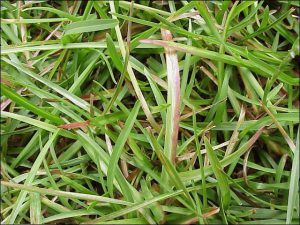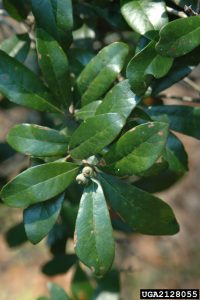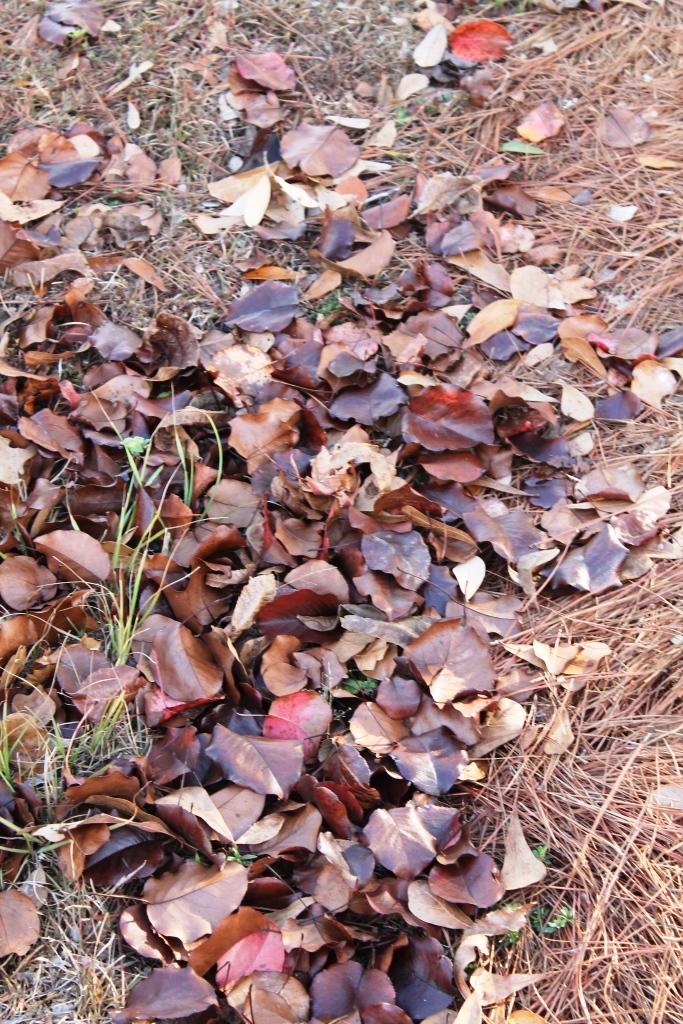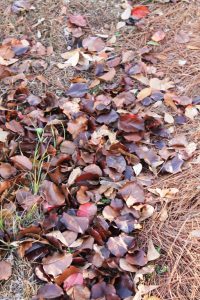by Larry Williams | Apr 13, 2017

Spittlebug damage on centipedegrass. Photo credit: Larry Williams UF/IFAS
Mole crickets, chinch bugs and spittlebugs are common lawn insect pests to begin watching for this time of year.
Mole crickets can be active in lawns spring through fall, but the best window of opportunity to control them is in June and July.
Soap flushing is a technique to survey for mole crickets. Mix two ounces of liquid dishwashing soap in two gallons of water and apply with a sprinkling can to four square feet of turf in several areas where mole crickets are suspected. If an average of two to four mole crickets appear on the surface within several minutes, then a treatment is probably needed.
Chinch bugs only damage St. Augustinegrass. So if your lawngrass is something other than St. Augustine, don’t worry about this insect.
Damage from chinch bugs tends to begin in April. However, they are more likely to be active during warmer summer months through early fall in the more sunny areas of the yard, particularly if it’s dry.
Inspect a St. Augustinegrass lawn weekly during spring, summer and fall. Look for areas that quickly turn yellow and then straw brown. Part the grass at the margin of the yellowed areas and closely examine the soil surface and base of the turf for tiny insects. Immature chinch bugs are pink to red and are about the size of a pinhead. The adults are only 1/8 inch long and black with white wings.
Spittlebugs attack all turfgrass species but centipedegrass is their favorite. The first generation of adult spittlebugs is abundant in June and the peak population usually occurs in August to early September.
An early sign of spittlebug activity are masses of white, frothy spittle found in the turf. Each piece of spittle contains one immature spittle bug. Infested turf turns yellow and eventually brown. Damage resembles chinch bug injury but usually first appears in shady areas. Closer inspection reveals discolored individual grass blades with cream colored and pinkish-purple streaks running the length of individual blades. As the population builds, the ¼ inch long adults are abundant. As you walk through or mow an infested area, numerous adult spittlebugs fly short distances when disturbed. Adults are black with two orange transverse stripes across their wings.
Correct lawn management can minimize many pest problems. If a pesticide becomes necessary to control a lawn pest, be sure to follow the product’s label instructions and precautions.

by Larry Williams | Feb 25, 2017
 Florida farmers produce more fresh tomatoes than any other state. Yet Florida home gardeners find it difficult to grow tomatoes. By changing a few basic practices, home gardeners can increase their chances of success.
Florida farmers produce more fresh tomatoes than any other state. Yet Florida home gardeners find it difficult to grow tomatoes. By changing a few basic practices, home gardeners can increase their chances of success.
My philosophy of growing tomatoes in Florida (mixed with science) is outlined below.
First, I choose mostly determinate varieties that have resistance to key diseases.
Most gardeners are used to growing indeterminate varieties. Farmers mostly grow determinate types. Determinate varieties are more compact and produce most of their crop at one time. You can usually harvest all the fruit in two to five pickings and then pull up the plants. Indeterminate varieties, sometimes referred to as “everbearing” tomatoes, set fruit along a vine stem that continues to grow all season.
Correct variety selection is a must for success with tomatoes in Florida.
One reason home gardeners have a difficult time growing tomatoes in Florida is because of incorrect variety selection. Most popular (indeterminate) tomato varieties lack resistance to Tomato Spotted Wilt Virus (TSWV) and bacterial wilt. These two diseases wreak havoc in home as well as commercial plantings. Amelia, a determinate variety that has TSWV resistance, has started showing up in some retail outlets. For a list of other varieties to look for, consult this publication, “Tomatoes in the Florida Garden”.
Secondly, I plant reasonably early – usually after April 1 (maybe earlier this year due to warm late winter). Tomato plants grow best when temperatures exceed a specific base temperature for a certain number of days (referred to as heat units or degree days). Tomatoes are heat-loving plants that need a long warm growing period to grow from seed to fruit. Optimum fruit set occurs within a narrow night temperature range. Tomatoes produce the largest yields of highest quality fruits when day temperatures are in the range of 80 to 85ºF and when night temperatures remain above 62 but below 72ºF.
Thirdly, I fertilize to produce a healthy, sturdy plant when the plant is young. With the first open flowers, I reduce fertilization (particularly the nitrogen) to about half the original rate. When the first fruits are about two inches in diameter, I reduce fertilization a little more. Once I harvest the first tomatoes, I further reduce the fertilizer to about ¼ the original rate or completely quit fertilizing. Many home growers fertilize tomatoes too much. This results in a big green plant with few tomatoes. This reduction in fertilization is mainly important with the amount of nitrogen being applied. The plant still benefits from adequate potassium.
There are two basic phases of growth in plants – vegetative and reproductive. When a tomato plant begins to produce flowers, it is becoming sexually mature (switching from a vegetative phase of growth to a reproductive phase of growth). Just remember that as plants mature and fruit, the demand for nitrogen decreases. Excessive nitrogen can reduce fruit set and development. Too much nitrogen keeps the plant in a vegetative phase of growth resulting in a big, overly vigorous, green plant with few to no fruit.
As heat, humidity, rains, diseases and insects increase during summer months, tomato production declines. Entire plants may begin to die. At this point, I’m thankful for any production I got. I do away with the plants and find something else to do other than grow tomatoes.
by Larry Williams | Jan 26, 2017

Live oak with immature acorns. Photo credit: Wendy VanDyke Evans, Bugwood.org.
Do you have more acorns than you know what to do with? When oaks produce loads of acorns, it sometimes is called a “mast” year. Do you remember the oak tree pollen and all those catkins that fell from oaks earlier in spring?
Catkins are the male flowers in oaks. Some people refer to them as tassels or worms. The airborne pollen from these catkins were part of the reproductive process in fertilizing the female oak flowers that ultimately resulted in all of these acorns. Oaks produce separate male and female flowers on the same tree. Female flowers in oaks are very small. You’d have to look very close to see them. Many oaks did well in their reproductive efforts this spring. Acorns are oak seeds. This entire process is part of the cycle of life.
There are theories about mast years, wildlife’s use of these acorns and what gardeners can expect next year as a result of this year’s abundant acorn crop. Timing of mast years is still a mystery. Numerous theories exist ranging from weather to geography to the life cycles of predators.
The most likely reason for high production seems to be weather-related. When oak trees have favorable weather at the time of oak flowering and good growing conditions, the mast seems to be increased.
But mast years happen irregularly, making it difficult to understand what causes a mast year. Heavy acorn production can occur twice in a row or it might be separated by several years or more. There’s no good way to predict it.
Mast years are important to wildlife, as acorns are an important food for many animal species. In low crop years, birthrate for some wildlife species, such as squirrels, will decline the following year. This also may involve increased competition for food and survival rates. The recent crop means that more young are likely to be produced by animals that forage for acorns.
Wildlife play a big role in forest regeneration. When acorns drop out of oaks, many animals help distribute these seeds. Squirrels can bury hundreds of acorns. Some of these acorns germinate and grow to become the next generation of oak trees. Some will be eaten by birds, bears, deer, rodents, including squirrels, and other wildlife. Rodents are in turn eaten by carnivores and deer browsing shapes which kinds of plants become established and survive. All those acorns have far-reaching impact on wildlife and our forests.
So, try to keep this in mind as you are fussing with all those acorns in your lawn and landscape this season.

by Larry Williams | Dec 2, 2016
 Billions of leaves blanket the fall landscape and are bagged by hundreds of homeowners to be placed curbside for local trash pick-up.
Billions of leaves blanket the fall landscape and are bagged by hundreds of homeowners to be placed curbside for local trash pick-up.
Many of these leaves could be easily turned into valuable mulch or compost.
Why do all those fall leaves end up in bags to be discarded?
It’s probably because the homeowner is overwhelmed by the volume. For instance, one resident reported raking more than 100 large bags of leaves from his half-acre property. One large oak tree can contain over 250,000 leaves!
Bagged and discarded leaves could become a quality mulch or could be composted.
Homeowners have tools for reducing 100 bags of leaves to 10 in their own backyards.
Shredding and composting can reduce leaf volume by 90 percent and provides a manageable quantity of valuable mulch and an excellent organic source for composting and converting into rich humus to improve garden soil.
Shredded leaves stay seated better on the landscape than whole leaves. They also do a better job of holding moisture in the soil and don’t mat down like whole leaves.
But how do you shred leaves if you don’t have a costly leaf shredder?
All you need is a lawn mower, a little extra time and a concern for the environment. Just put the leaves on the lawn in rows around three feet wide and two feet deep.
Then, with the lawn mower at the highest wheel setting, run over the pile. If the mower has a bag attachment, collecting shredded leaves is a neat and easy task.
Without a bag, the easiest way to collect them is to put a 9-by-12-foot drop cloth parallel to the row of leaves. Then, by running the mower in one direction so the leaves are discharged onto the cloth, cleanup is easier.
Throw the shredded leaves in the compost pile to cut the volume by another 50 percent.
Shredded leaves will shrink within a week and compost faster than whole leaves.
To compost dry leaves, add water, a little garden soil and a cup of garden fertilizer.
For more information on gardening and landscaping, contact the UF/IFAS Extension Office in your County.

by Larry Williams | Oct 26, 2016

Saddleback Caterpillar – Image Credit Matthew Orwat
The reality of what happens deep down in the darkness of a fire ant mound hidden to human eyes or in the tunnels of a mole cricket where only creepy crawly things dare to enter may be too scary to believe.
University of Florida Institute of Food and Agricultural Sciences along with USDA introduced a tiny South American fly to the U.S. to help control the pesky imported fire ant. Literally, these introduced phorid flies cause the imported fire ants’ heads to fall off. They then use the decapitated heads to reproduce. The flies hover above the ants, dive in, latch on to the ant’s body and inject their eggs. The egg hatches, and a maggot wiggles its way into the ant’s head, where it grows for two to three weeks before secreting a chemical that dissolves the membranes holding the ant’s body together. In a few hours the ant’s head falls off. The maggot eats everything in it and then uses it as a pupae case. Gruesome, isn’t it?
Assassin bugs are frequently seen slowly crawling on shrubs in our landscapes. Most are brown to black but many are brightly colored. A common species is reddish-orange in the nymph stage. Assassin bugs feed on many harmful insects. Caterpillars are their favorite food.
They digest their prey before eating it. They do this by piercing their victim with their sharp beak, injecting digestive enzymes. This causes chaos on the unfortunate insect’s nervous system and liquefies the internal organs. The liquefied contents are then consumed, leaving only the shell of its kill. How tragic.
The larra wasp, an introduced predatory insect by University of Florida entomologists, enters a mole cricket tunnel. The female wasp will pounce on the mole cricket, wrestle with it and sting it on its soft underside. This immobilizes the mole cricket long enough to allow the wasp to deposit a single egg on its underside. The mole cricket recovers and burrows back into the ground. The wasp larva eventually hatches and slowly eats the mole cricket alive. Poor mole cricket.
We mere mortals should be aware of these horrifying happenings occurring in our own backyards. And we should be frightened by those people who attempt to kill every six-legged critter in sight because they have wrongly identified them as bad. In reality, less than one percent of all insects that exist are damaging to our plants. Most are of no consequence to our lawns, landscapes or gardens. And many are beneficial.
These beneficial insects are helping us gardeners battle the bad bugs during Halloween and year round.








